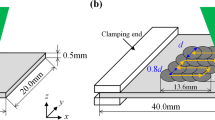Abstract
The role of the initial residual stresses (IRS) induced by the milling on the efficacy of laser shock peening (LSP) was investigated numerically on IN718 specimens. Three milling conditions exhibiting high (3.5 μm), medium (1.1 μm), and low (0.6 μm) surface roughness were considered for LSP. Experimentally measured (from XRD) milling-induced sub-surface (up to 60 μm depth) residual stresses were introduced into the simulations of LSP as predefined fields. The role of spot diameter with the IRS on the LSP-induced residual stress was studied systematically. For most cases, the tensile IRS from milling caused a significant decrease in the magnitude of maximum compressive residual stresses induced by LSP.







Similar content being viewed by others
Reference
B. Denkena and L. De Leon, Milling Induced Residual Stresses in Structural Parts out of Forged Aluminium Alloys, Int. J. Mach. Machin. Mater. Indersci. Publ., 2008, 4(4), p 335–344. https://doi.org/10.1504/IJMMM.2008.023717
B. Li, X. Jiang, J. Yang, and S.Y. Liang, Effects of Depth of Cut on the Redistribution of Residual Stress and Distortion during the Milling of Thin-Walled Part, J. Mater. Process. Technol., 2015, 216, p 223–233. https://doi.org/10.1016/j.jmatprotec.2014.09.016
S. Mehmood, A. Sultan, N.A. Anjum, W. Anwar, and Z. Butt, Determination of Residual Stress Distribution in High Strength Aluminum Alloy after EDM, Adv. Sci. Technol. Res. J., 2017 https://doi.org/10.12913/22998624/68729
P. Peyre, R. Fabbro, P. Merrien, and H.P. Lieurade, Laser Shock Processing of Aluminium Alloys, Appl. High Cycle Fatigue Behav. Mater. Sci. Eng: A, 1996, 210(1), p 102–113. https://doi.org/10.1016/0921-5093(95)10084-9
K. Ding and L. Ye, “Laser Shock Peening: Performance and Process Simulation,” Woodhead Publishing, 2006.
K.-H. Fuh and C.-F. Wu, A Residual-Stress Model for the Milling of Aluminum Alloy (2014–T6), J. Mater. Process. Technol., 1995, 51(1), p 87–105. https://doi.org/10.1016/0924-0136(94)01355-5
M.M. El-Khabeery and M. Fattouh, Residual Stress Distribution Caused by Milling, Int. J. Mach. Tools Manuf, 1989, 29(3), p 391–401. https://doi.org/10.1016/0890-6955(89)90008-4
R. Fabbro, J. Fournier, P. Ballard, D. Devaux, and J. Virmont, Physical Study of Laser-produced Plasma in Confined Geometry, J. Appl. Phys, Am. Inst. Phys., 1990, 68(2), p 775–784.
L. Berthe, R. Fabbro, P. Peyre, and E. Bartnicki, Wavelength Dependent of Laser Shock-Wave Generation in the Water-Confinement Regime, J. Appl. Phys. Am. Inst. Phys., 1999, 85(11), p 7552–7555. https://doi.org/10.1063/1.370553
P. Peyre, I. Chaieb, and C. Braham, FEM Calculation of Residual Stresses Induced by Laser Shock Processing in Stainless Steels, Model. Simul. Mat. Sci. Eng., 2007, 15(3), p 205. https://doi.org/10.1088/0965-0393/15/3/002
I. Angulo, F. Cordovilla, A. García-Beltrán, N.S. Smyth, K. Langer, M.E. Fitzpatrick, and J.L. Ocaña, The Effect of Material Cyclic Deformation Properties on Residual Stress Generation by Laser Shock Processing, Int. J. Mech. Sci., 2019, 156, p 370–381. https://doi.org/10.1016/j.ijmecsci.2019.03.029
H.K. Amarchinta, R.V. Grandhi, K. Langer, and D.S. Stargel, Material Model Validation for Laser Shock Peening Process Simulation, Model. Simul. Mat. Sci. Eng., 2009, 17(1), p 015010. https://doi.org/10.1088/0965-0393/17/1/015010
P. Mylavarapu, C. Bhat, M.K.R. Perla, K. Banerjee, K. Gopinath, and T. Jayakumar, Identification of Critical Material Thickness for Eliminating Back Reflected Shockwaves in Laser Shock Peening – A Numerical Study, Opt. Laser Technol., 2021, 142, p 107217. https://doi.org/10.1016/j.optlastec.2021.107217
F.Z. Dai, J.Z. Lu, Y.K. Zhang, D.P. Wen, X.D. Ren, and J.Z. Zhou, Effect of Laser Spot Size on the Residual Stress Field of Pure Al Treated by Laser Shock Processing: Simulations, Appl. Surf. Sci., 2014, 316, p 477–483. https://doi.org/10.1016/j.apsusc.2014.07.166
J.S. Kim, H.S. Nam, Y.J. Kim, and J.H. Kim, Numerical Study of Laser Shock Peening Effects on Alloy 600 Nozzles With Initial Residual Stresses, J. Press. Vessel. Technol., 2017 https://doi.org/10.1115/1.4035977
J.M. Pereira and B.A. Lerch, Effects of Heat Treatment on the Ballistic Impact Properties of Inconel 718 for Jet Engine Fan Containment Applications, Int. J. Impact Eng, 2001, 25(8), p 715–733. https://doi.org/10.1016/S0734-743X(01)00018-5
M. Smith, “ABAQUS/Standard User’s Manual, Version 2016,” (United States), Dassault Systèmes Simulia Corp, 2016.
Y. Zhenchao, X. Yang, L. Yan, and X. Jin, The Effect of Milling Parameters on Surface Integrity in High-Speed Milling of Ultrahigh Strength Steel, Proc. CIRP, Elsevier, 2018, 71, p 83–88.
P. Ballard, J. Fournier, R. Fabbro, and J. Frelat, Residual Stresses Induced by Laser-Shocks, Le J. de Phys. IV, EDP Sci., 1991, 1(C3), p C3-487.
Acknowledgments
The authors are grateful to IIT-Hyderabad and DMRL for the support provided during the course of this study. Special thanks are due to Dr. T. Jayakumar, Retd. DRDO Fellow and Fmr Scientist IGCAR, Prof. P. Prem Kiran, and Prof Jay Prakash Gautam from the University of Hyderabad for the extensive discussions carried out during the study.
Author information
Authors and Affiliations
Corresponding author
Additional information
Publisher’s Note
Springer Nature remains neutral with regard to jurisdictional claims in published maps and institutional affiliations.
This invited article is part of a special topical issue of the Journal of Materials Engineering and Performance on Residual Stress Analysis: Measurement, Effects, and Control. The issue was organized by Rajan Bhambroo, Tenneco, Inc.; Lesley Frame, University of Connecticut; Andrew Payzant, Oak Ridge National Laboratory; and James Pineault, Proto Manufacturing on behalf of the ASM Residual Stress Technical Committee.
Rights and permissions
Springer Nature or its licensor (e.g. a society or other partner) holds exclusive rights to this article under a publishing agreement with the author(s) or other rightsholder(s); author self-archiving of the accepted manuscript version of this article is solely governed by the terms of such publishing agreement and applicable law.
About this article
Cite this article
Singh, A., Chinthapenta, V. & Mylavarapu, P. Efficacy of Laser Shock Peening Post-milling: A Semi-numerical Study. J. of Materi Eng and Perform 33, 4106–4113 (2024). https://doi.org/10.1007/s11665-024-09241-9
Received:
Revised:
Accepted:
Published:
Issue Date:
DOI: https://doi.org/10.1007/s11665-024-09241-9



